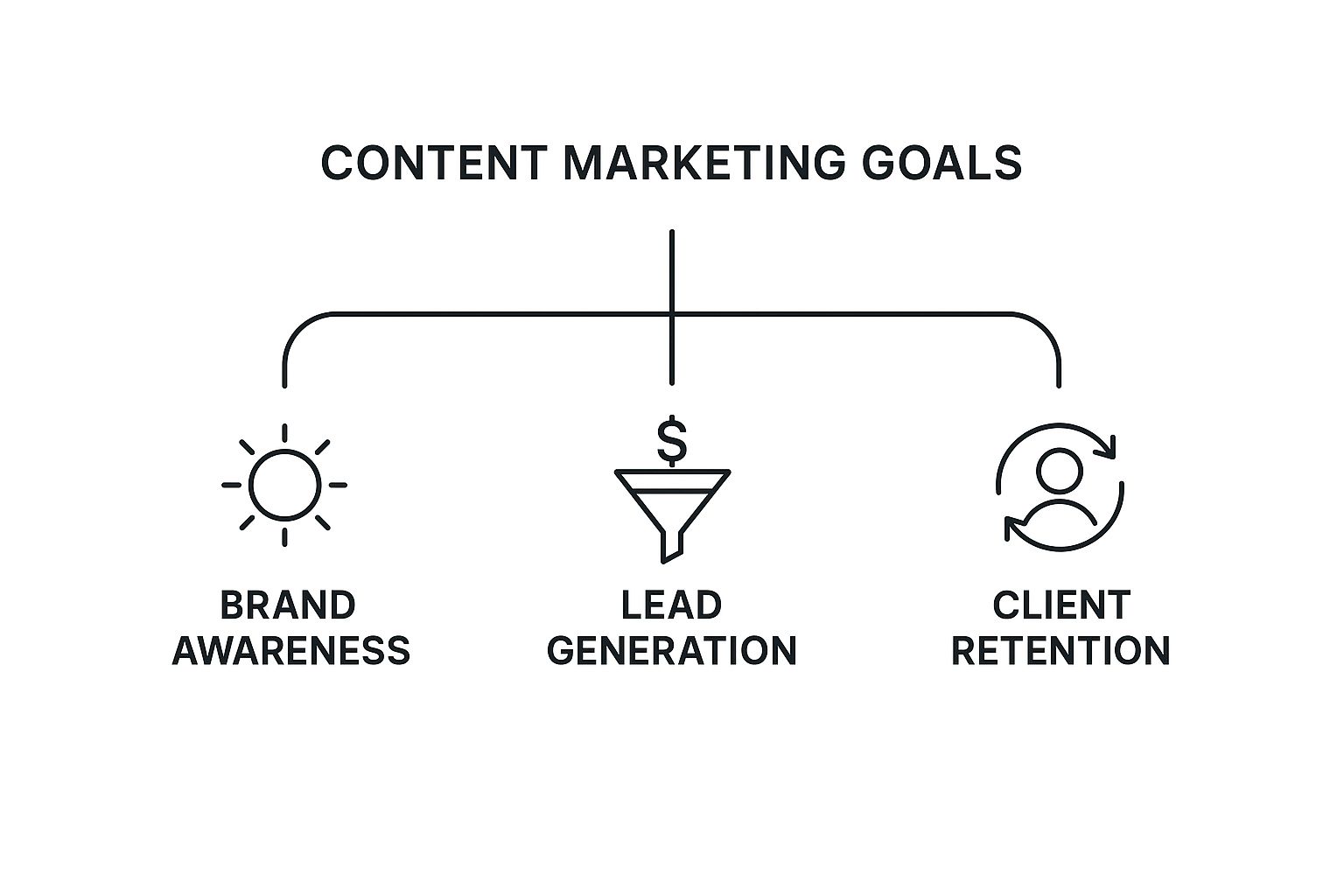In professional services, trust isn't a bonus—it's the product. Content marketing is the engine for building that trust at scale, acting as your firm's most valuable, non-billable hour. It’s how you prove your expertise and build a reputation long before a prospect ever picks up the phone.
Why Content Marketing for Professional Services Is Non-Negotiable

When clients hire a professional services firm, they aren’t buying a tangible product. They’re buying confidence. Confidence in your ability to solve their most complex, high-stakes challenges.
For years, the go-to marketing playbook involved sponsorships, steak dinners, and networking events. But that world is fading because the modern B2B buyer has changed the game. Their journey no longer starts with a referral; it starts on Google, LinkedIn, or an industry podcast, where they quietly vet experts from behind a screen.
This shift means your firm's reputation is now forged in the digital realm. Your website, articles, and webinars have become your digital handshake. This is the core of content marketing for professional services: taking the deep expertise locked in your team's heads and translating it into valuable, accessible insights that your ideal clients are actively searching for.
You're not just a service provider anymore. You're an educator and an authority, generously sharing wisdom. This transforms your firm from one of many options into the only logical choice.
The Business Case for Content
Still on the fence? The data tells a compelling story. The content marketing industry hit nearly $72 billion in 2023 and is projected to more than double by 2026.
More importantly, content marketing can slash customer acquisition costs by around 62% compared to traditional marketing, all while generating three times as many leads. It's not just about being seen; it's about being seen by the right people, efficiently and at scale. For a deeper dive into these core concepts, this comprehensive guide to digital marketing offers great foundational knowledge.
These figures prove that content isn't a "nice-to-have." It's a direct investment in your firm’s growth engine.
By sharing your expertise freely, you build an audience and a brand that generates demand for years to come. This strategy directly addresses how modern buyers make decisions, establishing your firm as the trusted authority when a challenge becomes urgent.
Ultimately, a solid content strategy doesn't just bring in more leads. It brings in better leads—pre-qualified, pre-educated, and pre-disposed to trust you—setting the stage for more meaningful commercial conversations.
Quick Wins for Professional Services Content
These steps don't require a massive budget. They require a commitment to sharing what you already know.
Building a Client-Centric Content Strategy
Content marketing for a professional services firm isn't about chasing random traffic. It’s a calculated play to attract, engage, and convert the right clients. A winning strategy cuts through the noise and offers specific solutions to high-value problems, making your firm the only logical choice.
It all starts with a deep, obsessive understanding of your Ideal Client Profile (ICP). This goes beyond demographics. You need to know their specific business challenges, operational headaches, and the strategic questions that keep them up at night. What trigger finally makes them search for a firm like yours? Nailing this is the key to creating content they can't ignore.
Defining Your Core Content Pillars
Once you know who you're talking to, you need to decide what to talk about. Don't try to be everything to everyone. Build your strategy around authority pillars: the core service areas or high-stakes problems where your firm has undeniable, world-class expertise.
Think of each pillar like a central hub. For an accounting firm, a pillar might be "International Tax Compliance for Tech Startups." For a law firm, it could be "Intellectual Property Protection for SaaS Companies." These pillars ensure every piece of content reinforces your specialized authority.
An authority pillar isn't just a topic; it's a declaration of expertise. It tells the market, "This is the specific, complex problem we are the best in the world at solving." This focus attracts high-fit clients with those exact needs.
To keep your content pipeline flowing, it’s crucial to find new angles within these pillars. Applying proven strategies for idea generation in business can help your team consistently brainstorm topics that resonate with your ICP.
Aligning Content With Client Goals
Your content must serve a business purpose. The infographic below breaks down how different goals—like building brand awareness, generating leads, and nurturing clients—form the backbone of a robust content plan.

As you can see, a powerful strategy meets clients wherever they are, from the moment they first hear about you to when they become a long-term partner. Each of these goals demands a different kind of content.
Mapping Content to the Client Journey
Finally, map your content formats to the different stages of your client's decision-making process. Someone just realizing they have a problem needs something different than someone ready to sign an engagement letter.
- Awareness Stage: Early on, prospects are researching their problem, not your firm. Your job is to be helpful. Blog posts and short, educational videos that answer their initial questions work wonders here.
- Consideration Stage: Now they're weighing options. This is where you showcase expertise. Think in-depth white papers, detailed webinars, and insightful case studies. You can see fantastic B2B content marketing examples that nail this stage.
- Decision Stage: When a client is about to choose, they need proof and confidence. This is where client testimonials, detailed success stories, and consultation offers provide the final nudge they need to commit.
Choosing Content Formats That Build Real Trust

Here's a hard truth: in professional services, the container for your ideas is as critical as the ideas themselves. When your business is built on expertise, the medium is the message. Get this right, and you build the genuine client trust that fuels growth.
If a potential client is vetting your firm for a high-stakes engagement, a flimsy, 300-word blog post isn’t going to move the needle. They’re digging for depth, for proof, for a reason to believe you're the expert.
This means your content marketing for professional services must be built around formats that signal substance and credibility.
Formats That Prove Your Expertise
To flex your firm's analytical muscle, you need formats that give you room to go deep. These are the foundational pieces that establish you as a true authority.
In-Depth Blog Posts and Articles: Go deep. The average top-ranking blog post is now over 1,400 words because audiences crave detailed, authoritative content. Use these long-form pieces to unpack complex industry challenges and stake your claim with a clear, expert point of view.
White Papers and Ebooks: These are your go-to for presenting proprietary research, a unique methodology, or a comprehensive framework. When you gate them behind a form, they become powerful lead magnets that attract prospects who are serious about finding a real solution.
Case Studies: This is arguably the single most important format in your arsenal. Nothing provides social proof like a client success story. It moves your claims from theory to reality, proving you deliver tangible results and answering a prospect's core question: "Can you solve my specific problem?"
Formats That Humanize Your Firm
Expertise gets you in the door, but people hire people. They want to work with experts they know, like, and trust. This is where content can humanize your partners and consultants in a way a corporate brochure never could.
Your experts are your firm’s greatest asset. Putting a face and voice to their knowledge transforms abstract expertise into a relatable, trustworthy source of advice. This personal connection is often the deciding factor for a potential client.
It's time to get your experts out from behind the curtain. Audiences want this connection; a staggering 83% of consumers want more video content from brands and experts. You can find more compelling data on content format performance to help make the case internally.
Webinars: Whether live or on-demand, webinars allow your experts to engage directly with an audience, demonstrating their command of a subject in real-time and fielding tough questions—a massive confidence builder.
Video Interviews: Short, punchy video interviews with your partners are gold. They put a human face to the firm’s name and are incredibly shareable on platforms like LinkedIn.
Podcasts: Don't underestimate the power of "borrowed trust." Getting your expert featured as a guest on an established industry podcast instantly places them in front of a built-in, highly relevant audience. It’s a shortcut to building authority. If that sounds interesting, check out our guide on how to get booked on podcasts.
Getting Your Content in Front of Decision-Makers
Creating brilliant content is only half the battle. In professional services, that content is worthless if the right people—the decision-makers—never see it.
This is where surgical distribution comes in. It separates firms that get noticed from those just adding to the noise. Forget generic social media blasts. Your goal is to place your expertise directly in the path of your ideal clients.
That means focusing your energy where senior leaders are already looking for advice. For most professional services, that conversation is happening on LinkedIn. Think of it as the digital equivalent of an exclusive industry conference.
The platform is perfect for positioning your experts as go-to authorities, but it goes way beyond just posting links.
Use LinkedIn for High-Value Connections
LinkedIn gives you a powerful set of tools to reach a sophisticated B2B audience. Your firm's partners and senior consultants must be active participants.
They should be in niche industry groups where your ideal clients discuss their biggest challenges. By sharing insightful comments and publishing compelling articles directly on the platform, they can grab the attention of C-suite executives in a genuine and helpful way.
Think of your content distribution not as a loudspeaker, but as a series of strategic, one-on-one conversations at scale. Each piece of content should feel like valuable advice delivered directly to the right person.
Build Your Own Audience With Email
While LinkedIn is fantastic for reach, email is where you build relationships.
A must-read email newsletter is one of the most potent weapons in your arsenal. It’s how you nurture prospects over the long haul with exclusive insights, turning casual subscribers into qualified, interested leads.
Remember, your newsletter isn't a sales pitch. It needs to be an indispensable resource—the kind of analysis and commentary your clients can't get elsewhere. Delivering that value week after week builds incredible trust and keeps your firm top-of-mind. It's a core component of a healthy B2B growth funnel.
Squeeze Every Drop of Value From Your Content
Finally, get smart about repurposing. A single webinar or in-depth white paper contains enough raw material for a dozen strategic content assets. Don't let that value go to waste.
Here’s a quick breakdown of how that might look:
- The Original Asset: A 45-minute webinar on a new industry trend.
- Four short video clips for LinkedIn, each highlighting a powerful takeaway.
- An in-depth blog post summarizing the webinar’s main arguments.
- A downloadable checklist based on the webinar’s actionable steps.
- An audiogram featuring a key quote to share across social media.
- A series of email tips dripped out to your newsletter subscribers.
This "create once, distribute forever" approach ensures your core insights reach the widest possible audience on the channels they actually use, maximizing your ROI.
Structuring a Realistic Content Marketing Team
 Let's bust a common myth: you do not need a massive marketing department to execute a killer content strategy. This is especially true for professional services firms, where every hour is a potential billable hour.
Let's bust a common myth: you do not need a massive marketing department to execute a killer content strategy. This is especially true for professional services firms, where every hour is a potential billable hour.
The secret isn't a bigger team. It's a smarter, leaner one that leverages your most valuable asset: your internal experts.
Even companies with huge budgets struggle with this. We see marketers spending over $45,000 a month on content, yet a whopping 66.5% still say they have trouble with resource allocation. This pain is familiar in professional services, where it's a constant battle to prioritize content when client work is calling.
This is why you need a different approach—one that doesn’t pile unrealistic demands on your partners.
The Hybrid Model: Your Best Bet
For most firms, the most effective structure is a hybrid model. It’s simple: you blend the deep knowledge of your internal subject matter experts (SMEs) with the specialized skills of external talent.
Your partners and senior consultants are the "brains" of the operation. Their job isn’t to become expert writers or video editors. It’s to provide the core insights—the raw genius—that only they possess.
The external team—freelancers, an editor, or a specialized agency—acts as the production crew. They take those raw insights and transform them into polished, high-performing content. This setup respects everyone’s time and expertise, creating a scalable engine for your firm's thought leadership.
The goal isn't to turn your experts into marketers. It's to create a seamless process that extracts their knowledge with minimal disruption to their primary, client-facing responsibilities.
The Role of the Content Champion
For this hybrid model to work, one person inside your firm has to own it. We call this person the Content Champion.
This isn't necessarily a senior partner. It's often better if they aren't. They just need to understand the firm's strategic goals and act as the crucial link between your busy experts and your external content team.
The champion's role includes:
- Scheduling brief interviews with your SMEs.
- Coordinating with external writers to hand off the raw material.
- Managing the content calendar to ensure a steady flow.
- Getting final sign-off from stakeholders before publication.
This person is the glue holding your content operation together. Without them, the best strategy will falter.
Efficient Knowledge Extraction
So, what's the biggest hurdle? Getting that brilliant knowledge out of your busiest people's heads.
The solution is an efficient knowledge extraction workflow. Instead of asking a partner to block out a day to write a 2,000-word article (a request that will be ignored), you schedule a 30-minute interview on a specific topic. You hit record.
That recording is now your raw material. It's gold.
A skilled writer can take that transcript and spin it into an in-depth blog post, a script for a short video, or the foundation for a B2B podcast episode. If you're curious about that last one, our guide on how to start a B2B podcast has some great ideas.
This is also where flexible staffing models like digital marketing outsourcing solutions can be a game-changer for handling specialized production tasks. This approach keeps your experts in their zone of genius while ensuring your content pipeline never runs dry.
Measuring What Matters and Proving ROI
Vanity metrics like social media likes and high page views might feel good, but they won’t impress your firm's partners. In professional services, the only language that speaks volumes is business impact.
To justify your investment in content marketing for professional services, you must draw a straight line from your efforts to the bottom line. This means shifting focus from fuzzy "awareness" to concrete business outcomes. Forget vanity; we're talking about value.
Tracking Metrics That Drive Business
To build an undeniable business case, you must connect your content to tangible results. This is how you prove content is a critical driver of revenue, not just a marketing expense.
Here’s where to focus your energy:
Lead Quality: It’s not about how many people download your content, but who is downloading it. Are your articles attracting prospects that fit your ICP? Track the titles, industries, and company sizes of the leads your content generates.
Consultation Requests: This is a key metric. Track how many "contact us" or "request a consultation" forms are filled out by someone who started their journey on your blog or by watching a webinar. This provides a direct link from content to a sales conversation.
Keyword Rankings for High-Intent Searches: Don't just track any keyword. Focus on the ones that signal commercial intent, like "law firm for IP protection" or "M&A advisory services." Ranking for these terms means you’re catching demand at the most crucial moment.
The most powerful metric is 'content-influenced revenue.' By connecting your marketing platform to your CRM, you can track every single deal that was touched by your content—whether a client read a blog post, attended a webinar, or downloaded a guide. This paints a crystal-clear picture of your ROI.
Ultimately, measuring what matters is about proving how your expertise—shared through content—builds the trust necessary to win high-value clients. This is also a huge piece of the puzzle if you're serious about figuring out how to become a thought leader in your space.
When you can walk into a partners' meeting and show a direct link between an article and a closed deal, your content program becomes undeniable.
Frequently Asked Questions
Jumping into content marketing always kicks up a few questions. Below are the most common hurdles professional services firms face, with straight-talking advice to help you move forward.
How Much Should We Budget for Content Marketing?
Let's reframe this. Instead of pulling a number out of thin air, calculate the lifetime value of a single new client.
If one engagement brings in five or six figures, does investing a few thousand dollars a month for content that consistently attracts those kinds of leads sound like a good deal? The ROI becomes clear when you look at it that way.
A smart way to start is by outsourcing to a writer or a small agency that specializes in your niche. This provides high-quality, consistent content from day one while you prove the concept internally. Remember, real results from content marketing for professional services don't happen overnight. Plan for at least a 6-12 month runway to see significant traction.
How Do We Get Our Busy Experts to Create Content?
This is the big one. The biggest mistake firms make is trying to turn their star partners into prolific writers. That's a recipe for frustration.
Instead, treat them like the invaluable sources of insight they are. Your job is to make it incredibly easy to get that knowledge out of their heads.
Don't ask a partner to write a 1,500-word blog post. Ask them for a 30-minute interview on a topic they could talk about in their sleep. This tiny shift respects their time and captures the gold.
Just hit record on these quick chats. A good content person can take that raw transcript and spin it into a polished article, a compelling case study, or even a script for a short video. This approach makes expert-driven content creation scalable, no matter how packed everyone's calendars are.
If We Can Only Do One Thing, What's the Most Important Piece of Content to Create?
If you have to put all your chips on one format, make it the detailed client case study. Nothing builds trust faster or more effectively.
Case studies are your proof. They show potential clients you don't just talk a good game; you solve complex, real-world problems.
A great case study tells a story. It outlines a client's specific challenge, walks through the solution your firm delivered, and—most importantly—quantifies the results. It directly answers the one question every single prospect has: "Have you solved a problem exactly like mine before?"
At Fame, we specialize in turning the deep expertise within your firm into a powerful podcast that builds authority and drives real business growth. We handle the entire process, from strategy to production, so your experts can focus on what they do best. See how we can amplify your firm's voice at https://www.fame.so.

